At the Cala Mondragó beach, you and your family can experience countless nature adventures. Explore the breathtaking, nearly untouched beaches and coves or discover the diverse flora and fauna that the Nature Reserve Mondragó has to offer. Expansive cliffs, great hiking trails, old fortifications, almond plantations, and above all, pristine nature make the trip to this vast nature reserve an unforgettable experience.
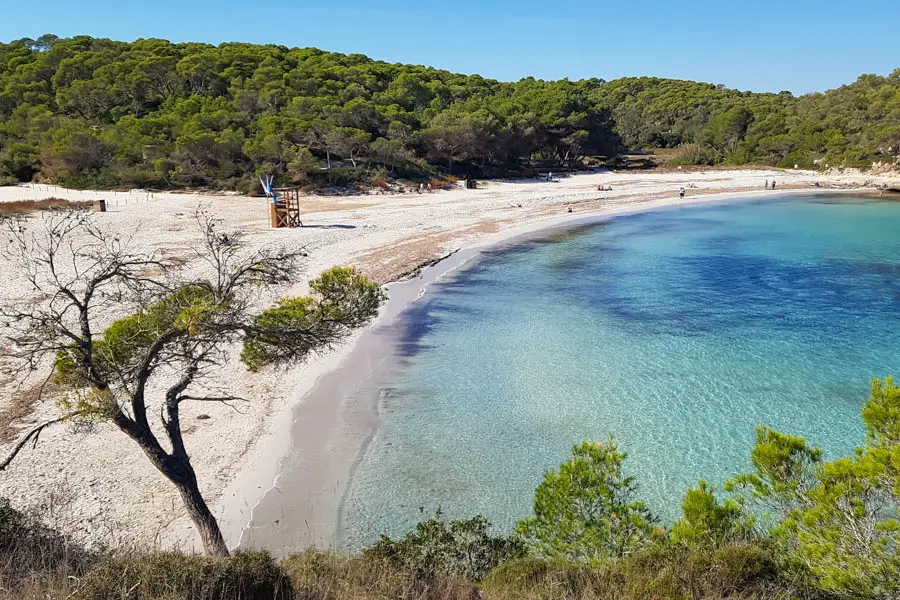
Transparency note: Some links in this post may lead to external booking opportunities. If a purchase is made, we receive a small commission. The price does not change for you.
In the more than 600-hectare nature reserve around Cala Mondragó, the Parc Natural de Mondragó, you can find three almost untouched white sand coves, five very simple hiking trails, and pine forests where endangered bird species like the kite nest. In the freshwater pond behind Cala Mondragó, flamingos rest in winter, and wild, romantic cliffs run along the sea. In short, this place has everything your family needs for an adventurous day trip or a relaxing beach day.
Cala Mondragó and Other Beaches in the Nature Reserve
Everyone talks about Cala Mondragó, which does exist, but it actually has another name: Ses Fonts de N’Alis. Besides that, there are two more beaches: the bay of S’Amarador and Caló d’es Borgit. All three beaches are easy to reach on foot from each other.
The Cala Mondragó Beach (Ses Fonts de N’Alis)
Cala Mondragó is the main beach of the nature reserve and the most well-equipped of the three coves. It offers a great panorama of the open sea and is bordered by impressive cliffs, especially to the east. Unfortunately, it is also the most popular of the three beaches in the park and is often very crowded.
In the summer, paddle boats are available for rent at Cala Mondragó. Snorkeling is also great, especially along the rock walls. The water is very shallow, making it suitable for both swimming and for smaller children.
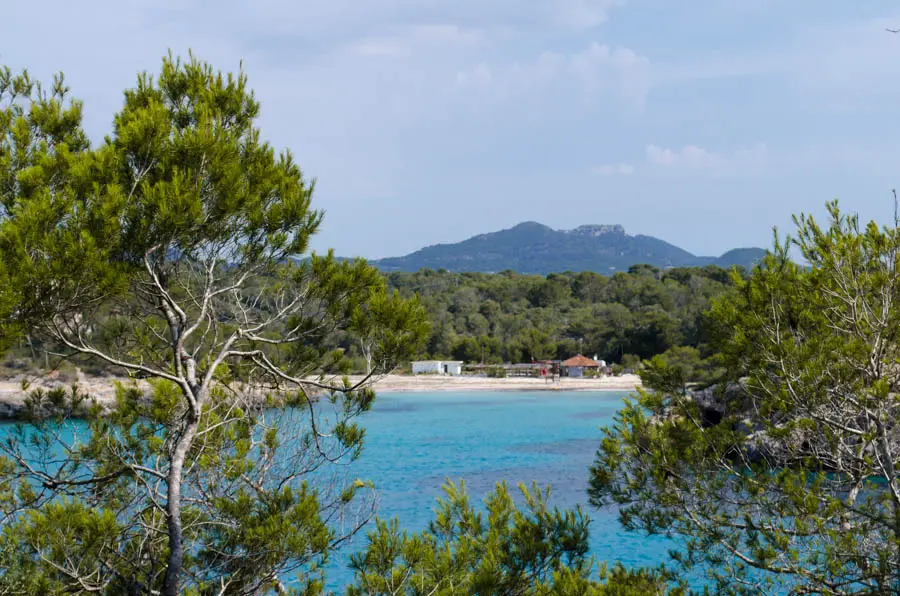
The parking lot is within easy walking distance, and a small beach bar provides refreshments. Lifeguards ensure the safety of swimmers from May to October. There are showers and a restroom available.
Right next to the beach, there is a small picnic area with wooden tables and benches. Two of the five hiking trails start here. This section is well-suited as a family beach, though it can be quite crowded and noisy, with few places to retreat.
Behind the beach Cala Mondragó, there is a brackish water pond that is home to a variety of animals. It is especially known for its rich birdlife, including many rare and protected species. One of the hiking trails runs along the water, leading you back to the parking lot in a relaxed walk.
The Beach S’Amarador
In our opinion, this is the most beautiful of the three beaches, mainly because it is much less developed than Cala Mondragó. However, this also means it offers less comfort. On the plus side, it is much more natural. In the hinterland, there is a riverbed that is dry most of the year and provides a habitat for many animals. Small exploration tours there are particularly fun, whether along the creek or a bit further into the agricultural parts of the Parc Natural de Mondragó.
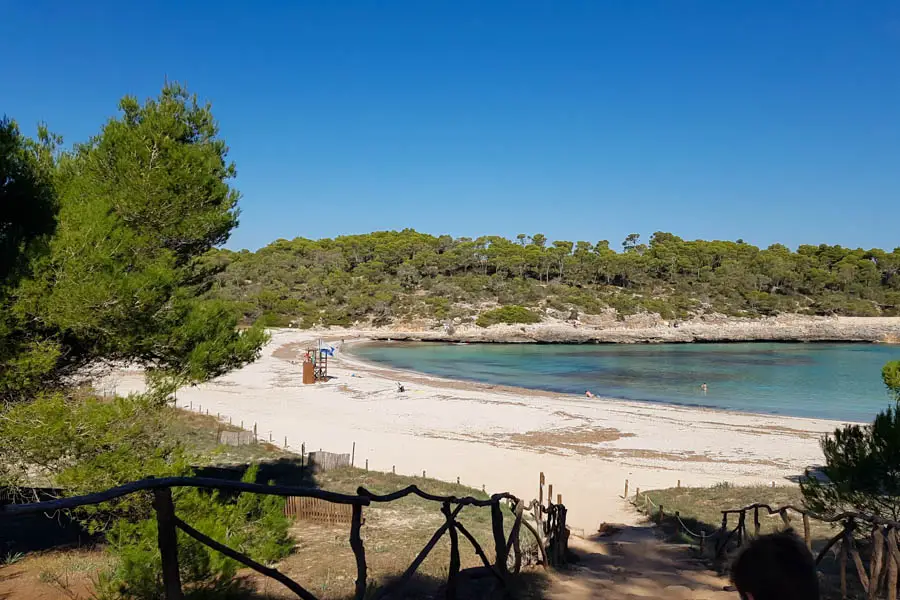
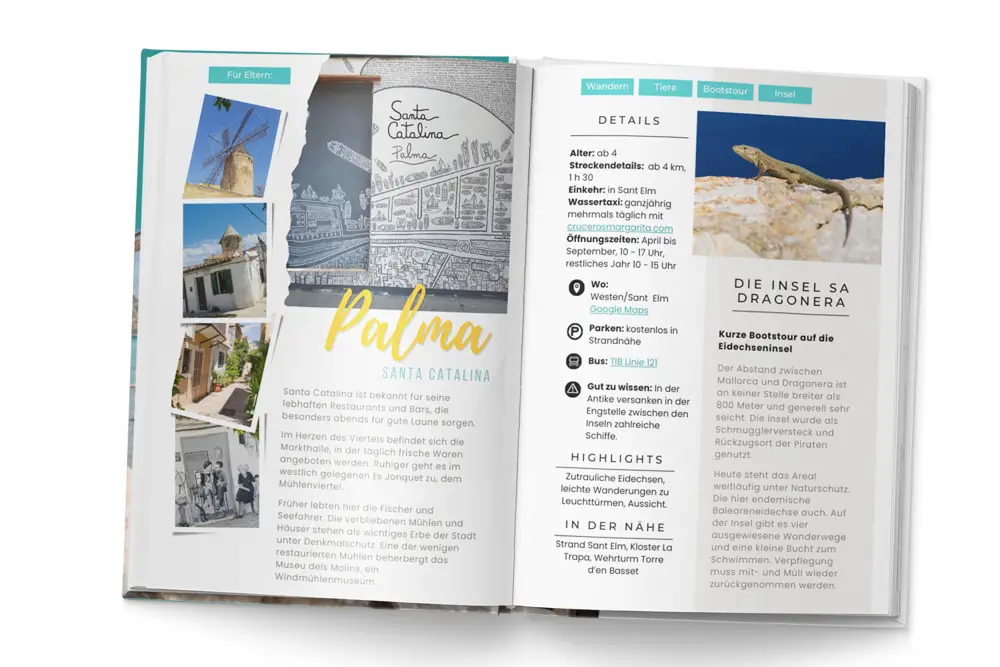
Du liebst diese Tipps?
Entdecke alle kinderfreundlichen Aktivitäten, Strände und exklusive Rabatte in meinem Mallorca-Guide.
The parking lot is still relatively close, and there is a small beach bar for refreshments. However, other conveniences, like a restroom and additional recreational activities, are lacking. There is also a small picnic area with tables and benches a bit away from the beach.
The Beach Calo d’es Borgit
Even less happens in the smallest bay of Parc Natural de Mondragó. It’s a bit off the beaten path and significantly smaller. The small sandy beach quickly fills up in summer, but it’s particularly beautiful in the evening light. The bay is untouched by tourist infrastructure and remains natural.
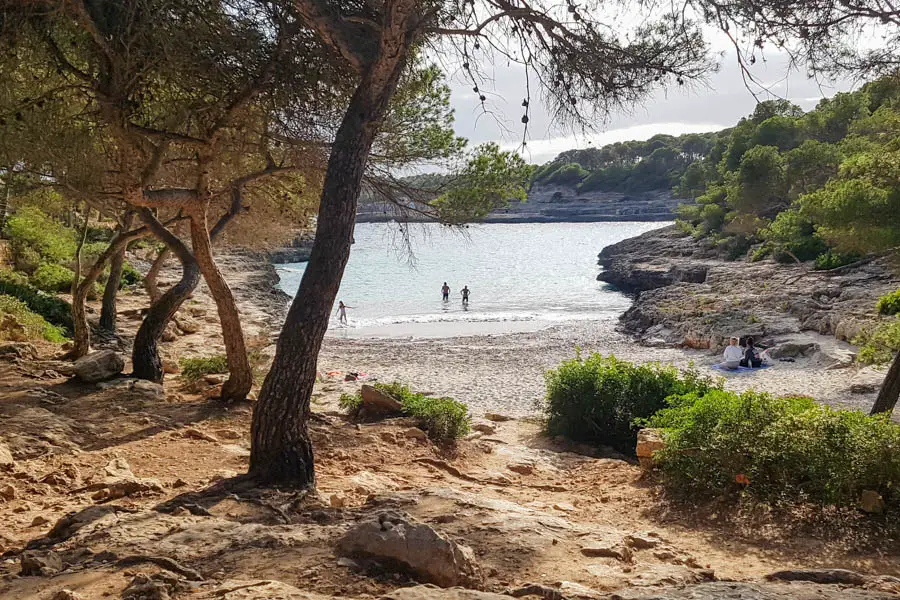
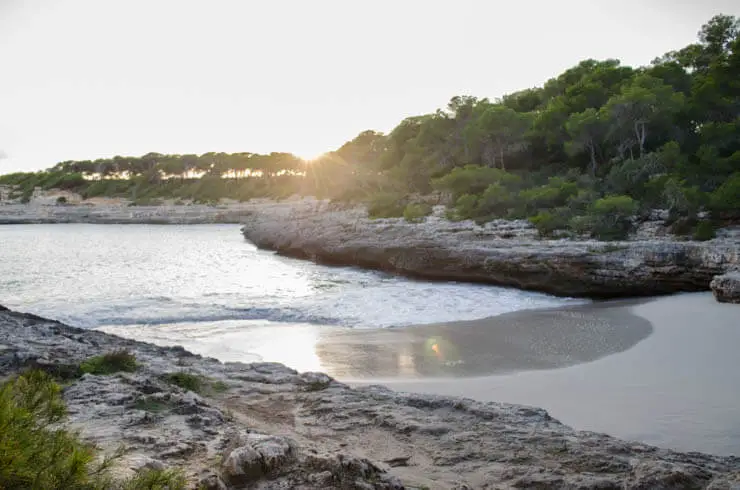
You can reach it by taking the small footpath behind the picnic area at Cala Mondragó. Alternatively, you can follow the trail markings along the coast. Along the way, you’ll also pass the ammunition depot and several other great viewpoints overlooking the sea.
Hiking in the Nature Reserve and at Cala Mondragó
The Parc Natural de Mondragó is great for easy short hikes with breaks for swimming. The trails are very well marked. There are a total of five circular routes, all of which are easily manageable with children. Each of the two parking lots has trails leading to various points in the nature reserve. Number five is in the middle. Depending on available time, stamina, and interest, you can walk one, two, or all of the circular routes.
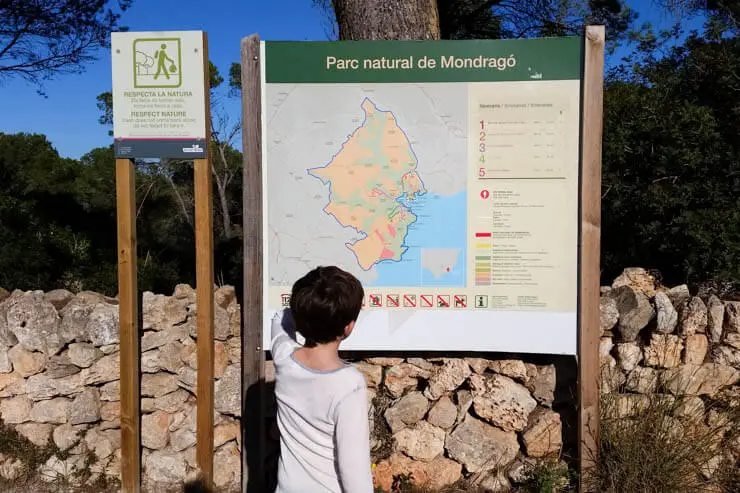
The easiest route is located at the parking lot of Ses Fonts de N’Alis. Conveniently, this is also the way from the parking lot to the beach of Cala Mondragó. Additionally, there is an information point here where you can sign up for guided tours through the nature reserve.
Circular Route 1: Ses Fonts de n’Alis Viewpoint
This circular route is so easy that it hardly counts. Instead of taking the paved road from the Ses Font de n’Alis parking lot, you take a short detour to the beach. The walk goes through the forest, passing by a small viewpoint and a brackish water pond, ending at the beach with Circular Route 1. In total, you will have covered 580 meters. There’s more to explore!
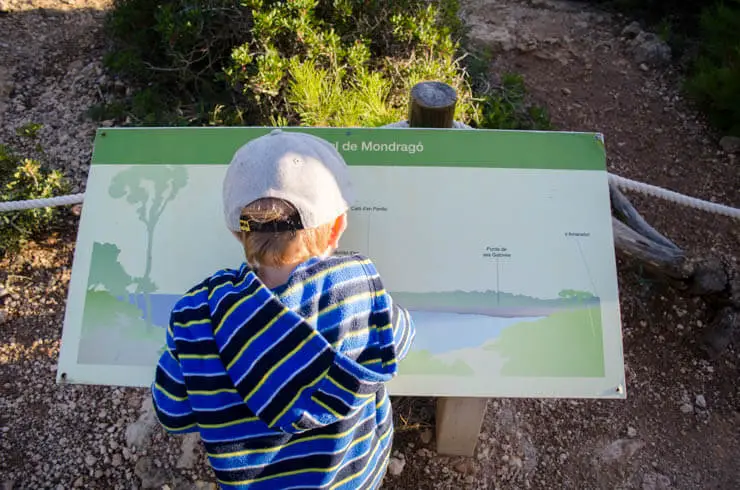
Brackish water has a lower salt concentration than normal seawater but higher than freshwater. This mixture makes it particularly rich in nutrients and provides an ideal habitat for various plant and animal species. It’s not uncommon to have visits from flamingos here during the winter months.
Circular Route 2: Volta a Sa Guardia d’en Garrot
Unlike the first route, this circular route is truly circular. It alternates between the hilly pine forests and the coast. When you’re at the beach, the starting point of the tour is to your left.
There are three viewpoints with spectacular views. One of them is a former ammunition depot. Only the bravest children dare to go in there. It’s best to bring a flashlight. This old military installation from the 1940s is strategically positioned so that you could monitor the entrance to the bay from inside.
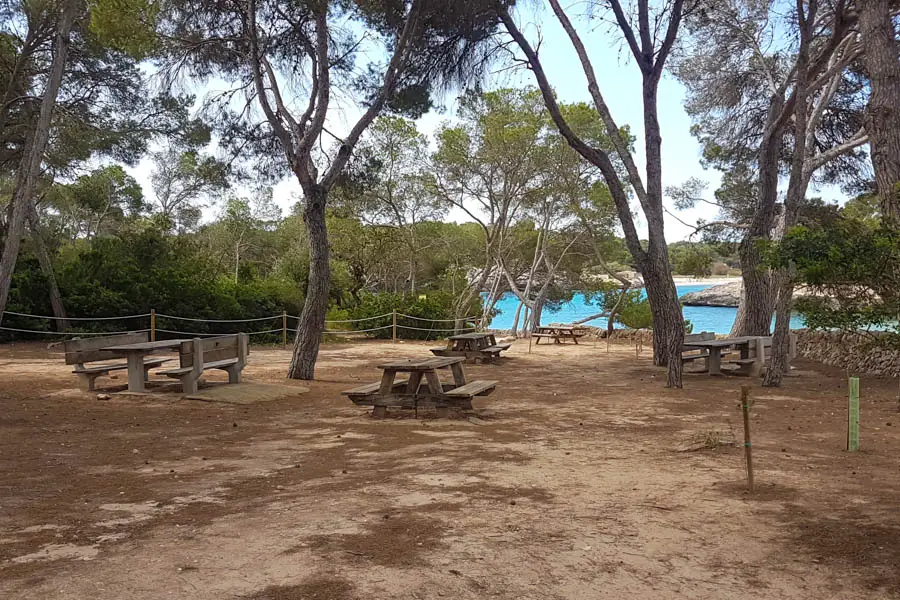
Even earlier, in the 16th century, there was a secret watchtower at the same location, part of the island’s surveillance system designed to warn residents of the surrounding area against pirate attacks. From the 19th century onwards, this spot was used to ambush smuggler gangs. And who knows who might be lurking around there nowadays.
If you continue, you’ll reach a smaller sandy cove, Es Caló des Borgit. The round trip to and from Cala Mondragó beach is just under a kilometer long. Need a break for a swim? We prefer S’Amarador over Ses Font de n’Alis / Cala Mondragó beach. While there are no pedal boat rentals or hotels there, it’s quieter and more spacious. Just follow the path along the cliffs, and you’ll soon be there.
Circular Route 3: Punta de ses Gatoves
This route is best accessed from the S’Amarador parking lot, so from the direction of Santanyí. On the way to the beach, take a well-marked right turn onto a circular walkway that eventually leads back to the S’Amarador beach.
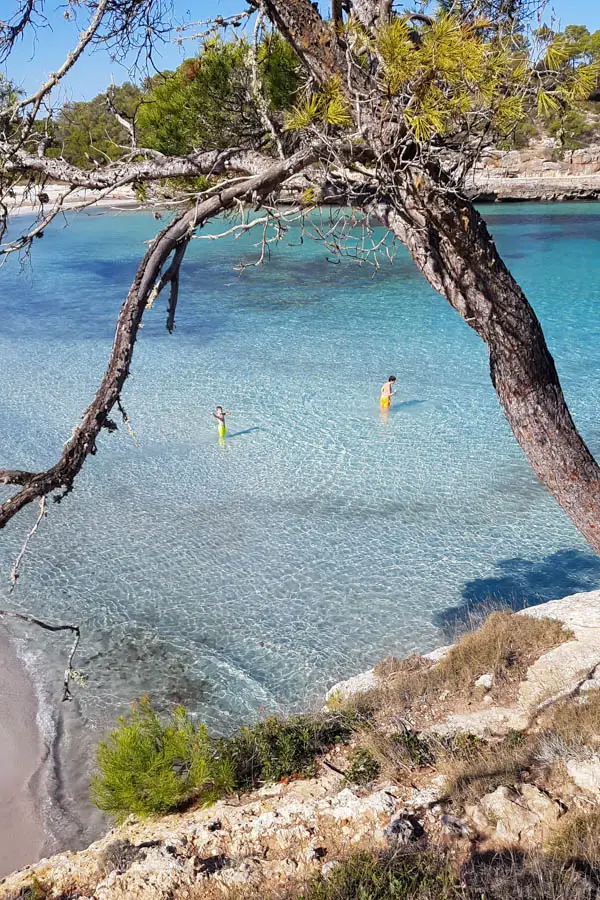
The path winds through pine forests lined with juniper and wild olive trees. There are also remnants of some old buildings, such as an old lime kiln. In these dry stone structures, quicklime was formerly produced from limestone. Everything needed—limestone and wood—was found nearby. The lime burned at about 800 degrees for ten to twelve days before being transported to the target areas.
This circular route is 660 meters long and leads you directly to the beach. There is also an area with picnic tables there. If you can hold off your hunger a little longer, it’s worth continuing because there’s an even better picnic spot ahead.
Circular Route 5: S’Hort d’en Metge
We’ve completed Circular Route 3. Where’s number four? It comes later because it leads back to the parking lot. First, we’ll head in the other direction and walk through the sand, almost to the other side of the bay.
Behind the pine trees there, the circular route begins. It takes you away from the beach and into the inland. It’s not as spectacular as the coastal paths, but there are fewer people walking here. There’s plenty of nature and plants to see, and lots of almond trees.
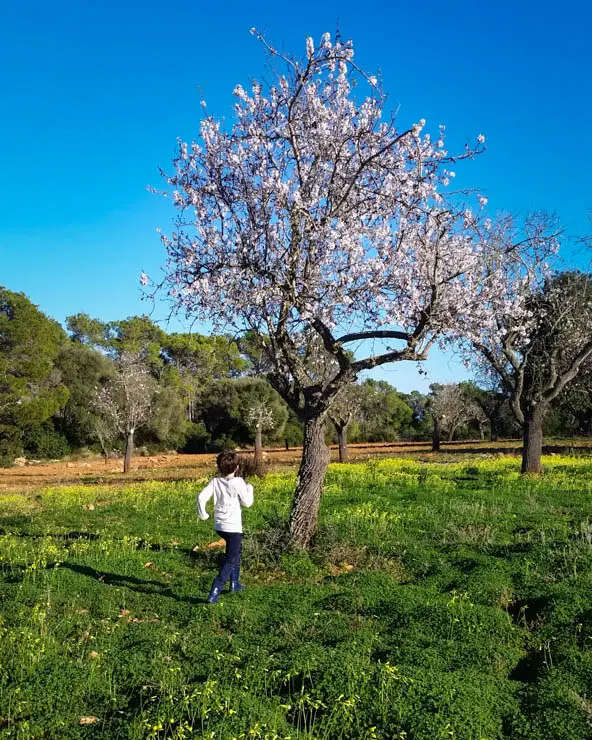
Right next to an old farmhouse, amidst a field full of almond trees, stands a picnic table. So, this circular route should definitely be walked during the almond blossom season in Mallorca. Imagine having a picnic under the blooming trees.
Depending on how long your picnic lasts, you’ll be back at the beach after half an hour or a full hour, but definitely within 1.2 kilometers.
Circular Route 4: S’Amarador
You can take this circular route to get from the S’Amarador beach to the parking lot. It starts at the small wooden bridge next to the picnic tables and leads you on a slight detour along the riverbed for 600 meters back to the parking lot.
Aktivitäten auf dem WasserWater Activities
Within the Parc Natural de Mondragó itself, apart from pedal boat rentals, no water sports are offered. The boats are equipped with slides and can be rented during the summer months. You can snorkel well along the cliffs of the bay, but it’s usually too crowded, so you won’t see many animals. Remote areas are better for that. (Check out here our favourite spots for snorkeling in Mallorca.)
The park administration occasionally offers boat tours. However, the Starfish Glassbottom Boat operates much more regularly. It shuttles between Cala d’Or and Cala Figuera with various tours during the summer. Another option is a speedboat ride from Cala d’Or.
Another great way to experience the maritime side of Parc Natural de Mondragó is with stand-up paddleboarding. Boards can be rented at various locations, providing you and even children with the opportunity to explore the more secluded sea caves and karst formations.
5 Facts about Parc Natural de Mondragó
- Palma Aquarium occasionally uses the park to release rehabilitated animals back into the wild. Many endangered species, such as native tortoises and the kite, appreciate the idyllic environment as much as numerous tourists.
- Established in 1988, the Mondragó Nature Park is the oldest nature park in Mallorca. Covering an area of over 7,000 hectares, it harbors a wide variety of native animals and plants, making it one of the most important conservation areas in the Mediterranean region.
- Over 200 different bird species call the Cala Mondragó area home, along with more than 1000 plant species.
- Reptiles are also abundant. Besides lizards, there are numerous land tortoises, which are also under protection.
TLDR
Unlike in other recreational areas, there are no barbecue facilities in the Cala Mondragó nature reserve. Lighting open fires is prohibited. It’s also essential to leave no trash on the trails. Guided tours of Mondragó are offered every Saturday. Register at the park’s information office.
Information Office Hours: 9 am to 4 pm.
Directions: There are multiple routes to access the nature reserve. One leads from Felanitx, Porto Cristo, or Cala d’Or to Ses Fonts de N’Alis beach on the east side of the park. Another from Palma and Santanyí leads to S’Amarador beach. Both beaches have parking lots.
Parking: Both lots charge a fee. Flat rate of 6 euros for the entire day. After 5 pm, only 2 euros are charged (the total amount is often requested).
Bus: A bus operates from Cala d’Or to Cala Mondrago in the summer.
Restrooms: Available at both parking lots and Ses Fonts de N’Alis beach.
Picnic Areas: At Ses Fonts de N’Alis and S’Amarador beaches.
Strollers: Only suitable from the parking lots to the beaches. The trails are not stroller-friendly.
Nearby Attractions: The town of Santanyí, Cala Llombards, Caló des Moro, Portopetro, and Portocolom.
Read More
Want more recommendations like this? Check out more than 100 day trips and excursions on Mallorca.
Planning your holiday on Mallorca:
Book your Flight here
Great Rental Car Offers